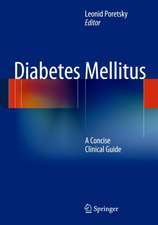Comparison of Type I and Type II Diabetes: Similarities and Dissimilarities in Etiology, Pathogenesis, and Complications: Advances in Experimental Medicine and Biology, cartea 189
Editat de Mladen Vranicen Limba Engleză Paperback – 28 aug 2013
Din seria Advances in Experimental Medicine and Biology
- 9%
 Preț: 719.56 lei
Preț: 719.56 lei - 5%
 Preț: 717.00 lei
Preț: 717.00 lei - 5%
 Preț: 717.00 lei
Preț: 717.00 lei - 15%
 Preț: 640.24 lei
Preț: 640.24 lei - 5%
 Preț: 715.71 lei
Preț: 715.71 lei - 5%
 Preț: 716.28 lei
Preț: 716.28 lei - 20%
 Preț: 691.93 lei
Preț: 691.93 lei - 5%
 Preț: 1031.00 lei
Preț: 1031.00 lei - 5%
 Preț: 820.42 lei
Preț: 820.42 lei - 5%
 Preț: 716.28 lei
Preț: 716.28 lei - 15%
 Preț: 641.38 lei
Preț: 641.38 lei - 5%
 Preț: 717.20 lei
Preț: 717.20 lei - 5%
 Preț: 715.35 lei
Preț: 715.35 lei - 5%
 Preț: 1113.83 lei
Preț: 1113.83 lei - 20%
 Preț: 1161.71 lei
Preț: 1161.71 lei - 5%
 Preț: 1170.51 lei
Preț: 1170.51 lei - 18%
 Preț: 1119.87 lei
Preț: 1119.87 lei - 5%
 Preț: 1288.48 lei
Preț: 1288.48 lei - 5%
 Preț: 1164.67 lei
Preț: 1164.67 lei - 5%
 Preț: 1101.73 lei
Preț: 1101.73 lei - 18%
 Preț: 1123.67 lei
Preț: 1123.67 lei - 5%
 Preț: 1435.64 lei
Preț: 1435.64 lei - 20%
 Preț: 1044.10 lei
Preț: 1044.10 lei - 18%
 Preț: 946.39 lei
Preț: 946.39 lei - 5%
 Preț: 292.57 lei
Preț: 292.57 lei - 18%
 Preț: 957.62 lei
Preț: 957.62 lei - 18%
 Preț: 1235.76 lei
Preț: 1235.76 lei - 5%
 Preț: 1231.55 lei
Preț: 1231.55 lei - 5%
 Preț: 1292.30 lei
Preț: 1292.30 lei - 5%
 Preț: 1102.10 lei
Preț: 1102.10 lei - 18%
 Preț: 1132.81 lei
Preț: 1132.81 lei - 5%
 Preț: 1165.19 lei
Preț: 1165.19 lei - 5%
 Preț: 1418.48 lei
Preț: 1418.48 lei - 5%
 Preț: 1305.63 lei
Preț: 1305.63 lei - 18%
 Preț: 1417.72 lei
Preț: 1417.72 lei - 18%
 Preț: 1412.99 lei
Preț: 1412.99 lei - 24%
 Preț: 806.15 lei
Preț: 806.15 lei - 18%
 Preț: 1243.29 lei
Preț: 1243.29 lei - 5%
 Preț: 1429.44 lei
Preț: 1429.44 lei - 5%
 Preț: 1618.70 lei
Preț: 1618.70 lei - 5%
 Preț: 1305.12 lei
Preț: 1305.12 lei - 18%
 Preț: 1124.92 lei
Preț: 1124.92 lei - 5%
 Preț: 1097.54 lei
Preț: 1097.54 lei - 15%
 Preț: 649.87 lei
Preț: 649.87 lei - 5%
 Preț: 1097.54 lei
Preț: 1097.54 lei - 18%
 Preț: 945.79 lei
Preț: 945.79 lei - 5%
 Preț: 1123.13 lei
Preț: 1123.13 lei - 20%
 Preț: 816.43 lei
Preț: 816.43 lei
Preț: 377.31 lei
Preț vechi: 397.16 lei
-5% Nou
Puncte Express: 566
Preț estimativ în valută:
72.20€ • 75.58$ • 59.74£
72.20€ • 75.58$ • 59.74£
Carte tipărită la comandă
Livrare economică 05-19 aprilie
Preluare comenzi: 021 569.72.76
Specificații
ISBN-13: 9781475718522
ISBN-10: 1475718527
Pagini: 364
Ilustrații: XI, 351 p. 75 illus.
Dimensiuni: 178 x 254 x 19 mm
Greutate: 0.63 kg
Ediția:1985
Editura: Springer Us
Colecția Springer
Seria Advances in Experimental Medicine and Biology
Locul publicării:New York, NY, United States
ISBN-10: 1475718527
Pagini: 364
Ilustrații: XI, 351 p. 75 illus.
Dimensiuni: 178 x 254 x 19 mm
Greutate: 0.63 kg
Ediția:1985
Editura: Springer Us
Colecția Springer
Seria Advances in Experimental Medicine and Biology
Locul publicării:New York, NY, United States
Public țintă
ResearchCuprins
Identification of Some Issues and Questions to be Answered in Comparing Type I and Type II Diabetes.- Is the Present Classification Valid And Sufficient.- Basis of the Present Classification of Diabetes.- Limitations and Problems of Diabetes Classification from an Epidemiological Point of View.- Gestational Diabetes: Problems in Classification and Implications for Long-Range Prognosis.- Heterogeneity within Type II and Mody Diabetes.- Genetics and Immunology.- The Genetics of Type I and Type II Diabetes: Analysis by Recombinant DNA Methodology.- Immunological Aspects of Type 1 and 2 Diabetes Mellitus.- Pathophysiology and Metabolic Abnormalities.- Insulin-Stimulated Glucose Disposal in Patients with Type I (IDDM) and Type II (NIDDM) Diabetes Mellitus.- Pathophysiology of Insulin Secretion in Diabetes Mellitus.- Internalization of Insulin: Structures Involved and Significance.- Insulin Resistance in Non-Insulin Dependent (Type II) and Insulin Dependent (Type I) Diabetes Mellitus.- Insulin-Mediated and Non-Insulin-Mediated Metabolic Effects of Gastroenteropancreatic Peptides in Type I and Type II Diabetes.- New Probes to Study Insulin Resistance in Men; Futile Cycle and Glucose Turnover.- New Methods for the Analysis of Insulin Kinetics in Vivo: Insulin Secretion, Degradation, Systemic Dynamics and Hepatic Extraction.- Atherosclerosis, the Major Complication of Diabetes.- Complications.- A Comparison of Kidney Disease in Type I and Type II Diabetes.- Diabetic Neuropathy.- The Wisconsin Epidemiologic Study of Diabetic Retinopathy a Comparison of Retinopathy in Younger and Older Onset Diabetic Persons.- Conclusions.- Some Summarizing Thoughts.









